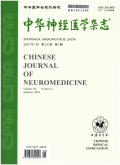微骨孔乙状窦后入路显微血管减压术治疗常见颅神经疾病的临床研究(附211例报道)
Treatment of patients with common cranial nerve diseases by microvascular decompression via a posterior sigmoid sinus key hole approach: a report of 211 cases
摘要目的 探讨显微血管减压术治疗常见颅神经疾病的并发症和临床疗效. 方法 对胜利油田中心医院神经外科自2006年9月至2011年5月收治且符合纳入标准的166例面肌痉挛和45例原发性三叉神经痛患者均行微骨孔乙状窦后入路显微血管减压术治疗,术后对2种患者并发症的发生情况进行分析,明确并发症发生情况有无差异;对患者进行至少3月以上临床随访,明确术后3d和术后3月颅神经症状消失情况有无差异. 结果 面肌痉挛和原发性三叉神经痛患者术后发热发生分别为51例、14例,面瘫发生分别为7例、1例,听力障碍发生分别为4例、2例,切口脑脊液漏发生分别为5例、2例,颅内感染发生分别为3例、2例;2种疾病患者手术并发症发生率比较差异无统计学意义(P>0.05).166例面肌痉挛患者术后3d颅神经症状消失109例,术后3月颅神经症状消失153例,比较差异有统计学意义(P<0.05);治愈率为92.2%;44例患者在术后3 d~3月间颅神经症状消失,存在颅神经症状延迟治愈情况.原发性三叉神经痛患者术后3d颅神经症状消失40例,术后3月颅神经症状消失42例,比较差异无统计学意义(P>0.05);治愈率为93.3%.结论 微骨孔乙状窦后入路显微血管减压术治疗面肌痉挛和三叉神经痛在手术操作并发症发生上无明显差异,且该手术方式疗效确切,面肌痉挛患者可在术后短期内逐渐获益.
更多相关知识
abstractsObjective To explore the incidence of operation complications and clinical curative effect of microsurgical vascular decompression on treatment of patients with common cranial nerve diseases. Methods One hundred and sixty-six patients with hemifacial spasm and 45 patients with primary trigeminal neuralgia,admitted to our hospital from September 2006 to May 2011,were collected in our study; all the patients under,vent microvascular decompression via a posterior sigmoid sinus key hole approach.Complications were analyzed after surgery for trigeminal neuralgia and hemifacial spasm patients to find the difference on complications between these 2 diseases. And at least 3-month clinical follow-up after microvascular decompression surgery was carried out to note the differences on disappearance of cranial nerve symptoms between 3 d and 3 months after the surgery. Results Postoperative fever in the patients with hemifacial spasm and trigeminal neuralgia was seen in 51 and 14 patients,prosopoplegia in 7 and 1 patient,hearing impairment in 4 and 2 patients,incisional cerebrospinal fluid leakage in 5 and 2 patients, and intracranial infection in 3 and 2 patients, respectively. Symptom disappearance was noted in 109 patients with hemifacial spasm 3 d after the surgery and in 153 patients 3 months after surgery with a cure rate up to 92.2%; 44 patients with disappearance of symptoms during the 3rd d to the 3rd months of surgery had delayed healing. The symptom disappearance was observed in 40 patients with trigeminal neuralgia 3 d after the surgery and in 42 patients 3 months after the surgery,with a cure rate reaching 93.3%. Conclusion No significant difference in the incidence of operation complications is noted between patients with trigeminal neuralgia and hemifacial spasm treated by microvascular decompression via a posterior sigmoid sinus key hole approach; the surgery enjoys exact effectiveness; and postoperative patients with hemifacial spasm may gradually get recovery in a short term.
More相关知识
- 浏览610
- 被引13
- 下载136


相似文献
- 中文期刊
- 外文期刊
- 学位论文
- 会议论文



 换一批
换一批 换一批
换一批



